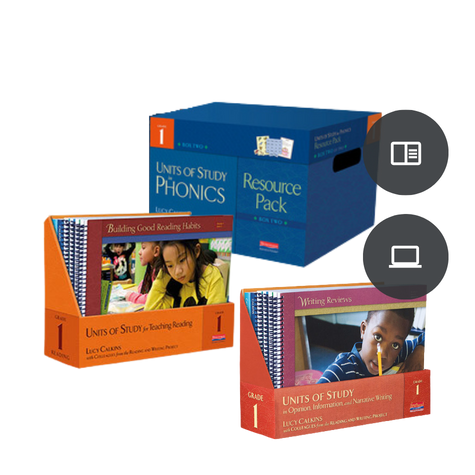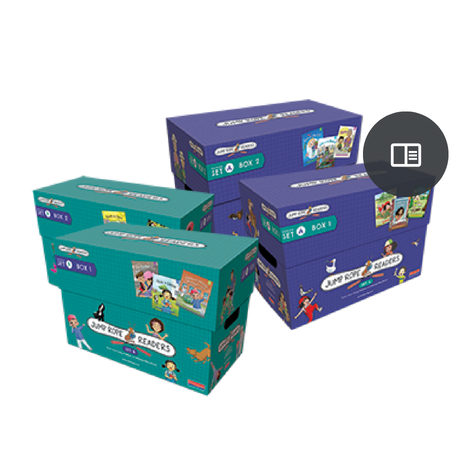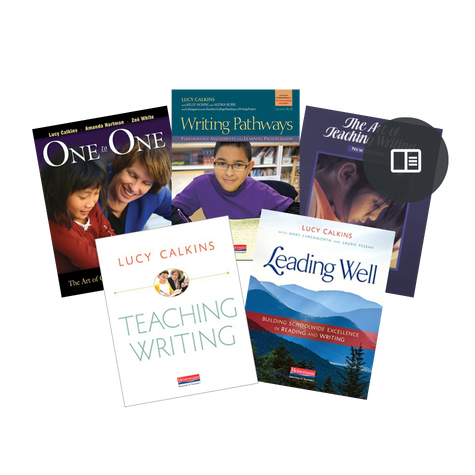Overview
-
Year Levels F–8
-
Curriculum ACT, NSW, NT, QLD, SA, TAS, VIC, WA
-
Subject Literacy
-
Resource Formats Print, Digital
-
Learning Focus Reading and writing workshops, Modelled reading, Guided reading
-
Last Updated Jan 2023
What it is
The Lucy Calkins Units of Study series includes lesson plans, mini-lessons, and small group work that help educators develop reading and writing skills in learners. It consists of three unique programs and supporting materials:
- Units of Study in Reading
- Units of Study in Writing
- Units of Study in Phonics
- Up the Ladder Reading Units
- Up the Ladder Writing Units
Built on best practice and a proven framework developed over decades, the series helps learners make progress independently and gives educators the opportunity to conduct strategic performance assessments to understand where learners are at.
When you provide students with constant opportunities to read and to write, and when you actively and assertively teach into their best efforts, their literacy development will astonish you, their parents, the school administrators — and best of all, the students themselves.
What it includes
Discover how Lucy Calkins’ Units of Study improves teaching outcomes.
Units of Study in Reading
Overview
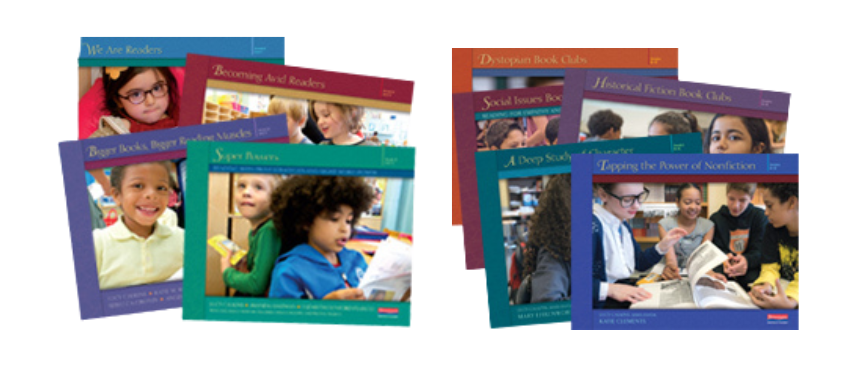
Units of Study in Reading units:
- help teachers use learning progressions to set students on trajectories of growth.
- help teachers provide their students with instruction, opportunities for practice, and concrete achievable goals to help them meet and exceed high expectations.
- are underpinned by proven tools and methods.
- have been planned, taught, revised, and retaught through a cycle of improvement involving thousands of classrooms in schools around the world.
- has a clear instructional arc, representing about five to six weeks of teaching, structured into three or four ‘bends in the road’.
Purchase of Units of Study in Reading, Third Edition includes access to digital resources.
Upon purchase, please contact Pearson at help@pearson.com.au to receive your licence.
Units of Study in Reading
New in 2023
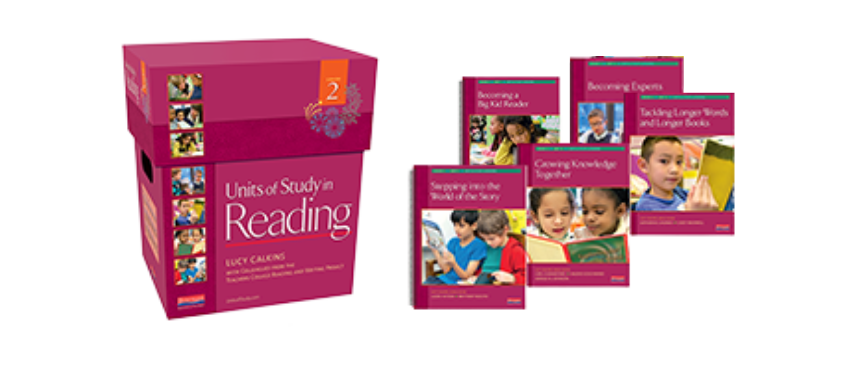
The new third editions of the Units of Study in Reading K–2, will do more to empower, revitalise and strengthen teachers than ever before. It offer teachers:
- concrete ways to bring science of reading research into vibrant workshop classrooms
- the best of what was in the previous editions, now streamlined and clarified
- new comprehension, language and knowledge generation research incorporated throughout.
Units of Study in Reading
Year K–5 reading components
Units of Study (4 units per grade)
- Grades K–2 includes one foundational unit and three other units to address reading fiction and informational texts, while Grades 3–5 each include two units in reading fiction and two in reading informational texts.
- Includes all teaching points, mini-lessons, conferences and small-group work needed to teach a comprehensive reading workshop curriculum.
A Guide to the Reading Workshop
- Describes the essential principles, methods, and structures of effective reading workshop instruction.
If...Then...Curriculum: Assessment-Based Instruction
- Contains additional and alternative units to support targeted instruction and differentiation.
Reading Pathways: Performance Assessments and Learning Progressions Grades 3–5
- Puts a system for assessing reading into teachers’ hands and into the hands of students.
Read-Aloud Sticky Notes (K–2) and Anchor Chart Sticky Notes (K–5)
- Large-format sticky notes help teachers create and evolve anchor charts across the units and pre-printed sticky notes for grades K–2 highlight possible teaching points during read-alouds.
Trade Book Packs
- Recommended optional purchase with Units of Study or as a separate purchase.
- Used as demonstration texts for teachers to model the skills and strategies students will try. Some of these books are also used for read-aloud and shared reading.
Online resources
- A treasure chest of resources, including bibliographies, short texts, reproducible checklists, pre- and post-assessments, homework, mentor texts, videos and weblinks.
Units of Study in Reading
Year 6–8 reading components
Units of Study (3 units per grade)
- Seven units of study covering non-fiction, character study, literary non-fiction and dystopian, social issues, historical fiction and author study book clubs
- Includes all teaching points, mini-lessons, conferences and small-group work needed for the reading workshop.
A Guide to the Reading Workshop: Middle School
- Also available for separate purchase.
Online resources
- A treasure chest of resources, including bibliographies, short texts, reproducible checklists, pre- and post-assessments, homework, mentor texts, videos and weblinks.
Units of Study in Writing
Overview
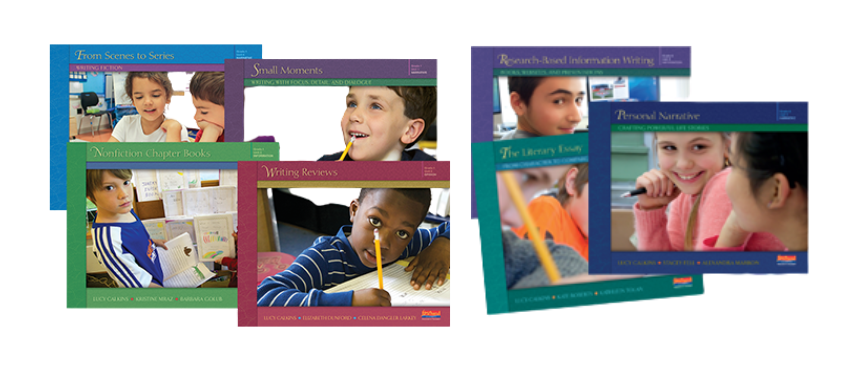
Units of Study in Writing units:
- help teachers use learning progressions to set students on trajectories of growth.
- help teachers provide their students with instruction, opportunities for practice, and concrete achievable goals to help them meet and exceed high expectations.
- are underpinned by proven tools and methods.
- have been planned, taught, revised, and retaught through a cycle of improvement involving thousands of classrooms in schools around the world.
- has a clear instructional arc, representing about five to six weeks of teaching, structured into three or four ‘bends in the road’.
Units of Study in Writing
Five-Part Workshop Framework
The writing workshop provides a simple and predictable framework so you can focus on observing students’ progress and teaching to their needs.
- Each session begins with a mini lesson. Students sit with a long-term partner while in the mini lesson.
- The mini lesson ends with the students being sent off to their own independent work.
- As students work, the teacher confers with them and leads small groups.
- Partway through independent work time, the teacher stands a delivers a mid-workshop teaching point.
- The workshop ends with a share.
Units of Study in Writing
Year K–5 Writing components
Units of Study in Opinion, Information, and Narrative Writing
Units of Study (4 units per grade)
- Organised around the three types of writing: opinion, information and narrative writing.
- Includes all of the teaching points, mini-lessons, conferences and small-group work needed to teach a comprehensive writing workshop curriculum.
A Guide to the Writing Workshop
- Describes the essential principles, methods and structures of effective writing workshop instruction.
- Also available for separate purchase.
If... Then... Curriculum: Assessment-Based Instruction
- Contains additional and alternative units to support targeted instruction and differentiation.
Writing Pathways: Performance Assessments and Learning Progressions Grades K–5
- A powerful assessment system offering learning progressions, performance assessments, student checklists, rubrics and levelled writing exemplars.
- Also available in a K–8 edition for separate purchase.
Trade Book Packs
- Recommended optional purchase with Units of Study or as a separate purchase.
- Across each unit, trade books are used to model effective writing techniques, encourage students to read as writers and provide background information.
Online resources
- The online resources offer:
- downloadable, printable files for the anchor charts
- student exemplars
- homework assignments
- checklists
- assessment resources.
Units of Study in Writing
Year 6–8 Writing components
Units of Study in Argument, Information, and Narrative Writing
Units of Study (3 units per grade)
- Organised around the three types of writing: argument, information and narrative writing.
- It includes all the teaching points, mini-lessons, conferences and small-group work needed to teach a comprehensive writing workshop curriculum.
A Guide to the Common Core Writing Workshop: Middle School
- Describes the essential principles, methods, and structures of effective writing workshop instruction.
- Also available for separate purchase
If... Then... Curriculum: Assessment-Based Instruction
- Contains additional and alternative units to support targeted instruction and differentiation.
Writing Pathways: Performance Assessments and Learning Progressions Grades 6–8
- A powerful assessment system offering:
- learning progressions
- performance assessments
- student checklists
- rubrics levelled writing exemplars.
- Also available in a K–8 edition for separate purchase.
Online resources
- The online resources offer:
- downloadable, printable files for the anchor charts
- student exemplars
- homework assignments
- checklists
- assessment resources.
Units of Study in Phonics
Overview
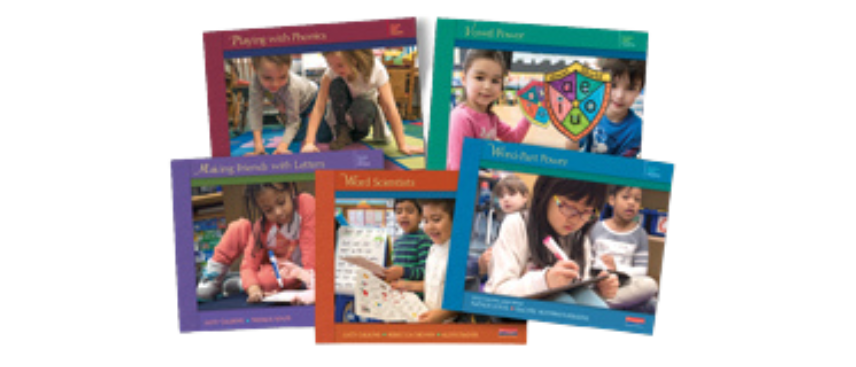
Built on best practices and a proven framework developed over decades, the phonics units:
- support explicit instruction, provide rich opportunities for practice and help teachers use learning progressions to set students on trajectories of growth
- provide a lean and concise instructional pathway in phonics that is realistic and doable, and that taps into students’ skills and energy for tackling the fabulous challenge of learning to read and write
- introduce high-leverage phonics concepts and strategies that help learners understand when, how and why, they can use phonics to read and write
- offer fun and engaging storylines, classroom mascots, songs, chants, rhymes, and games to help students enjoy learning phonics.
- align with state-of-the-art reading and writing workshops for a coherent approach in which terminology, tools, rituals, and methods are shared in ways that benefit both teachers and students.
Units of Study in Phonics
Year K–2 components
Grades K–2 include five units of study designed to be taught roughly at the same pace as corresponding reading and/or writing units of study.
A Guide to the Phonics Units of Study
- Provides an overview of the developmental progression that the series supports.
- Describes the essential principles, methods and structures that underpin this phonics curriculum.
Small Groups to Support Phonics
- Offers support in coaching into the work that students do during each session and in leading small groups to support students in transferring their phonics learning to their ongoing reading and writing.
Mentor text
- Each series set comes with a trade book to be used as a demonstration text for teachers to model the skills and strategies students will try.
Resource pack
Each resource pack contains:
- a variety of full-colour, illustrated posters, charts, picture, photo, word and letter cards
- copies of poems and songs
- assessment materials.
Online resources
Each unit includes:
- PDFs of materials included in the resource packs
- links to videos
- assessment tools
- small group resources.
Up the Ladder units
Overview
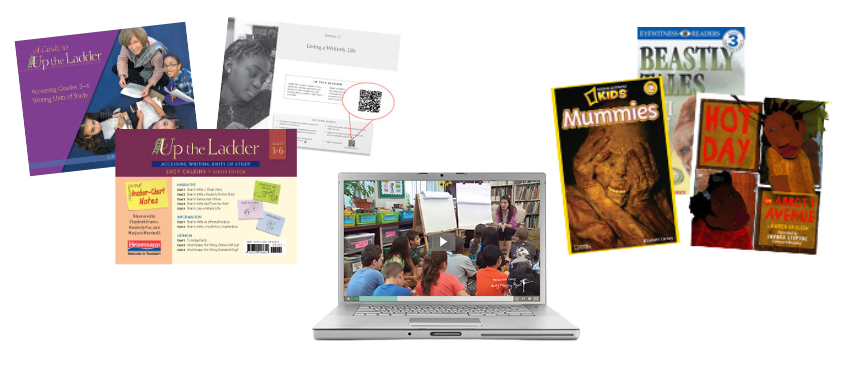
The Up the Ladder units include:
- A Guide to the Up the Ladder Units describing the essential principles, methods and structures that undergird this phonics curriculum along with an overview of the developmental progression that the series supports.
- Demonstration videos featuring TCRWP Staff Developers modeling how to teach each minilesson, accessed via QR codes at point-of-use.
- Anchor Chart sticky notes illustrating the teaching points for each day’s instruction to help teachers create and evolve anchor charts across the units.
- Trade book packs offering a variety of full-colour, illustrated posters; charts; picture, photo, word and letter cards; copies of poems and songs; assessment materials and much more.
- Online resources including downloadable anchor charts, paper-choice templates, student checklists, samples of student work, Spanish translation of resources such as anchor charts and student checklists, and more.
Up the Ladder units
Up the Ladder Writing units
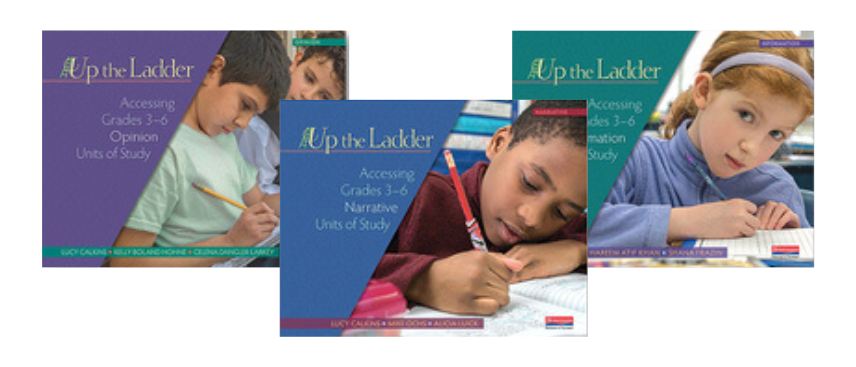
The Up the Ladder writing units teach foundational skills to ramp students up to work included in grade-level writing units. There are three Writing units including narrative, information, and opinion writing.
Up the Ladder units
Up the Ladder Reading units
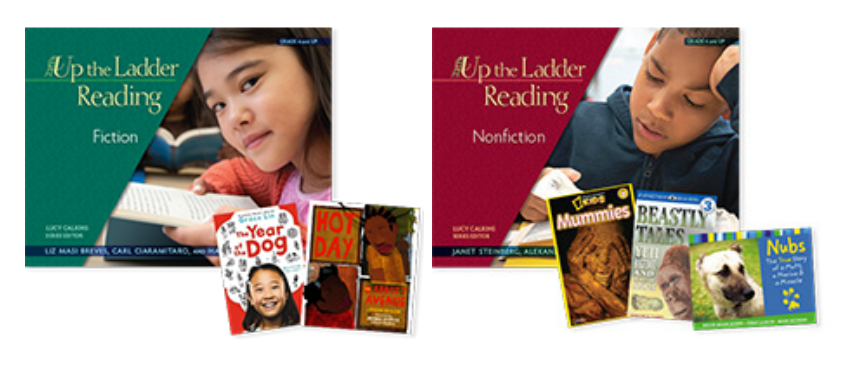
The Up the Ladder reading units introduce tools for repeated successful practice and rapid movement along a gradually increasing progression of challenges. It features two reading units covering fiction (Grades 3 and up) and nonfiction (Grades 4–6).

Meet the author
Lucy Calkins
As Founding Director of the Reading and Writing Project at Teachers College, Columbia University, Lucy Calkins spearheaded the development of impactful teaching methods and empowering professional development resources. Over 30 years in the making, the Lucy Calkins Units of Study have earned a reputation as state-of-the-art resources.
Samples & downloads
Tools and materials to help you unlock Lucy Calkins’ Units of Study
- Lucy Calkins — Units Of Study In Phonics Grades K 2, Third Edition — Overview — Sample Pages Download PDF (25.3MB)
- Lucy Calkins — Units Of Study In Phonics Grades K 2, Third Edition — Scope & Sequence — Sample Pages Download PDF (1.4MB)
- Lucy Calkins — Units Of Study In Phonics Grade K, Third Edition — Sample Pages Download PDF (7.9MB)
- Lucy Calkins — Units Of Study In Phonics Grade 1, Third Edition — Sample Pages Download PDF (10.6MB)
- Lucy Calkins — Units Of Study In Phonics Grade 2, Third Edition — Sample Pages Download PDF (12.1MB)
- Lucy Calkins Units of Study - K sample Download PDF (6.3MB)
- Lucy Calkins Units of Study - Grade 1 sample Download PDF (8.9MB)
- Lucy Calkins Units of Study - Grade 2 sample Download PDF (6.9MB)
- Lucy Calkins Units of Study - Grade 3 sample Download PDF (5.1MB)
- Lucy Calkins Units of Study - Grade 4 sample Download PDF (6.7MB)
- Lucy Calkins Units of Study - Grade 5 sample Download PDF (6.6MB)
- Lucy Calkins Units of Study - Grade 6 sample Download PDF (7.4MB)
- Lucy Calkins Units of Study - Grade 7 sample Download PDF (7.3MB)
- Lucy Calkins Units of Study - Grade 8 sample Download PDF (8.7MB)
